![]()
![]()
![]()
Use LEFT and RIGHT arrow keys to navigate between flashcards;
Use UP and DOWN arrow keys to flip the card;
H to show hint;
A reads text to speech;
54 Cards in this Set
- Front
- Back
|
International taxation What is: Corporate residence And Double taxation |
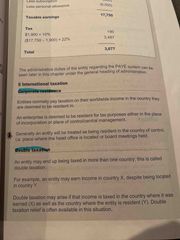
Back (Definition) |
|
|
The government will use tax to stimulate one sector of the economy- give example |
Allowances on capital expenditures may help develop or boost the manufacturing sector |
|
|
Give an example of how the government can use tax to control a part of the economy |
High taxes of things such as tobacco or alcohol- this can be used to put of consumers - both lead to a strain on the NHS etc |
|
|
In wealth of nations (Adam Smith) it is proposed that good tax should have the following characteristics: |
(CAFE) Convenient- easy to pay/ simply Absolute- certain not arbitrary, this means rules can’t change or numbers just pulled out of thin air Fair - reflect a persons ability to pay Efficient- low collection costs |
|
|
The 3 major principles of good tax policy are : |
Equity - a good tax should be fairly levied between one taxpayer and another Efficiency- a good tax should be cheap and easy to collect I.e PAYE used to collect tax at source on salaries and wages (direct tax) Economic effects- a good tax should consider the way in which tax should be collected |
|
|
What’s is good tax: the American institution of certified accountants (CPA) lists the following principles that a good tax policy should have: |
Appropriate government revenues- determining the amount of tax revenues and date of collection Convenience of payment Certainty Equity and fairness Economy in collection Economic growth and efficiency Minimum tax gap - the difference between actual collection and the amount due Neutrality Simplicity Transparency and visibility |
|
|
A tax is either : |
Direct tax or indirect tax |
|
|
Direct tax and indirect tax are: |
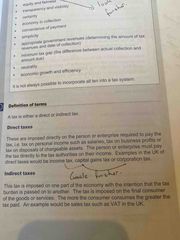
Back (Definition) |
|
|
The incidence of tax is the distribution of the tax burden I.e who is paying the tax This incidence can be be spilt into two elements :(which are?) |
Formal incidence Actual incidence |
|
|
The incidence of tax is the distribution of the tax burden I.e who is paying the tax This incidence can be be spilt into two elements :(which are?) |
Formal incidence Actual incidence |
|
|
What is formal incidence ? |
This is the person who has direct contact with the tax authorities I.e who is actually legally obligated to pay the tax I.e a accountant paying VAT to HMRC |
|
|
The incidence of tax is the distribution of the tax burden I.e who is paying the tax This incidence can be be spilt into two elements :(which are?) |
Formal incidence Actual incidence |
|
|
What is formal incidence ? |
This is the person who has direct contact with the tax authorities I.e who is actually legally obligated to pay the tax I.e a accountant paying VAT to HMRC |
|
|
Actual incidence is : (sometimes called effective incidence) |
This is the person who actually ends up bearing the cost of the tax I.e customers buy products where sales VAT has been added already |
|
|
Taxable person is : |
The person accountable for the tax payment I.e individual or entity |
|
|
Competent jurisdiction is? |
A taxable person normally pays tax in the country of origin. Competent jurisdiction is the tax authority that has the legal power to assess and collect the taxes - usually the combined responsibility of the central government and local authorities within the country. Tax law is enforceable by sanction, fines or imprisonment |
|
|
What is hypothecation ? |
Means that certain taxes are devoted entirely to certain types of expenditure I.e road tax is used to maintain and fix roads. London congestion charge is used to pay for transport for the area |
|
|
What is the tax gap? |
The is the gap between the tax that theoretically collectable and the amount that is actually collected. Tax authorities will aim to minimise this gap |
|
|
Incidence of tax is |
The distribution of the tax burden I.e who is paying the tax |
|
|
Tax rate structure 3 types of tax which are ? |
Progressive taxes: these take an increasing proportion of income as income rises i.e tax bands 20-40-50% Proportional taxes: these take the same proportion of tax as income rises i.e corporation tax Regressive taxes: they take a decreasing proportion of income as income rises i.e NI contributions 11% then 1 % |
|
|
Source of tax rules are : |
Legislation produced by a national government of the country I.e finance acts in the U.K. precedents based on previous legalisation. Tax authorities also issue interpretations I.e tax bulletins in the U.K./ statements of practice of tax authorities directives from international bodies such as the European Union guidelines on VAT Agreements between different countries such as double tax treaties I.e U.K./US double tax treaties |
|
|
Tax bases are classified to their tax base (what is being taxed) These bases are: (hint CIA) |
Consumption- I.e sales tax Income or profits - income and corporation tax in the U.K. assets - I.e capital gains tax Most countries separate different types of income into categories and have a set of rules to determine how that income will be taxed |
|
|
What is the standard proforma for calculating tax on trading income |

Back (Definition) |
|
|
Rules for what is allowed and disallowed for tax purposes |
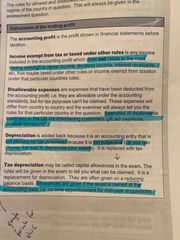
Back (Definition) |
|
|
What is capital gains tax? |
A capital gains tax is a tax on the profit realized on the sale of a non-inventory asset. The most common capital gains are realized from the sale of stocks, bonds, precious metals, real estate, and property. |
|
|
What is a tax treaty ? |
This a treaty between two countries and it is to stop someone paying tax twice i.e someone might pay tax in the country they earned the tax but also tax in their country of residence So the double tax treaty is to relief one side of this |
|
|
When an asset is sold any accounting profit or loss must be replaced with the tax equivalent known as the balancing charge or balancing allowance |
A balancing allowance (BA) - a tax loss on disposal of asset A balancing charge (BC) - a tax profit on disposal of asset |
|
|
The new extended proforma for profit or loss due to sale of an asset |
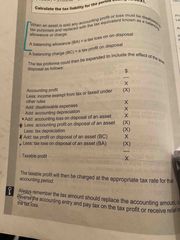
Back (Definition) |
|
|
The new extended proforma for profit or loss due to sale of an asset |
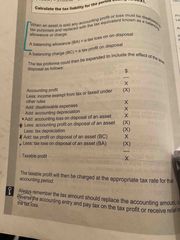
Back (Definition) |
|
|
Workings for calculating if a profit or loss has occurred on the sale of an asset |

Back (Definition) |
|
|
What is claim loss relief |
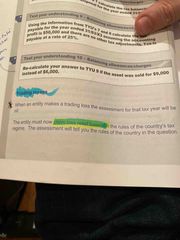
Back (Definition) |
|
|
There are 3 main methods of giving double taxation relief these are: (TED) |

Back (Definition) |
|
|
Types of overseas operations The features of operating as a subsidiary are: |
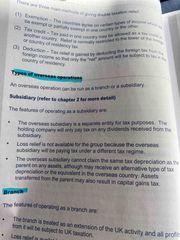
Back (Definition) |
|
|
The features of operating as a branch are: |
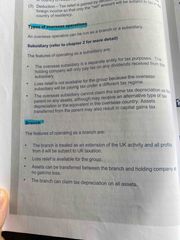
Back (Definition) |
|
|
Types of foreign tax There are two types which are: |
Withholding tax Underlying tax |
|
|
Withholding tax is ? |
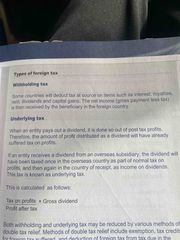
Back (Definition) |
|
|
Underlying tax is? |
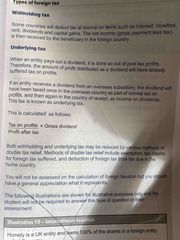
Back (Definition) |
|
|
What is the OECD model for tax convention? |
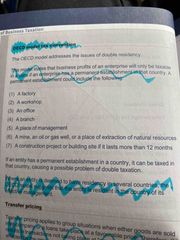
Back (Definition) |
|
|
What is transfer pricing? |

Back (Definition) |
|
|
What is the 1st rule of transfer pricing? |
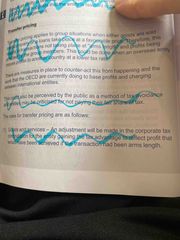
Back (Definition) |
|
|
What is the second rule of transfer pricing? |
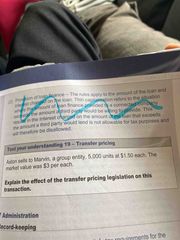
Back (Definition) |
|
|
Admin - record keeping to satisfy tax requirements What records need to be kept for corporate tax and sales tax? |
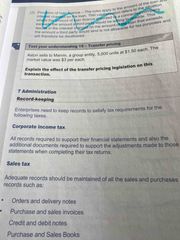
Back (Definition) |
|
|
Admin - record keeping to satisfy tax requirements For : Overseas subsidiaries Employee tax Minimum retention of records Payment of tax |
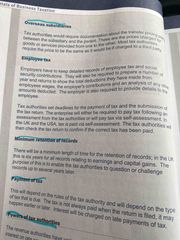
Back (Definition) |
|
|
Powers of tax authorities The revenue authorities have various powers to impose penalties and interest on late payment of tax. They have the powers to do the following: (RREEP) |
Review and query filed returns Request special reports if they believe information to be incorrect Examine records from previous years (up to 20 years) Enter and search entity’s premises and seize documents Pass on information to foreign tax authorities |
|
|
What is tax avoidance and tax evasion ? |
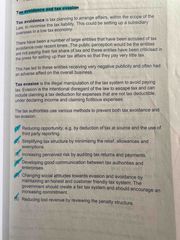
Back (Definition) |
|
|
Chapter 1 summary |
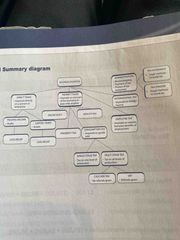
Back (Definition) |
|
|
What is corporation tax and income tax ? |
Corporation tax is the tax a business pays on its net profits and income tax is tax paid on an individuals profit or income (normally taken by PAYE method ) |
|
|
How is the tax to pay recorded in the accounts? |
DR income tax expense account (SPL) CR income tax current liabilities (SOFP) |
|
|
What was the net amount if £140 had been received after adding 20%? What was the net amount if £140 had been received after deducting 20%? |
A. £116. (140/1.20) B. £175. (140/0.8) |
|
|
Taxable employee benefits are ? |
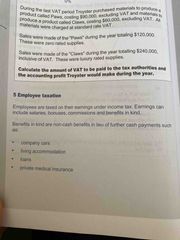
Back (Definition) |
|
|
Benefits of having a PAYE system |
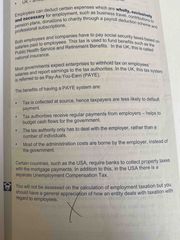
Back (Definition) |
|
|
Tax authorities have methods to prevent tax evasion and avoidance they are? (6) |

Back (Definition) |
|
|
OECD model tax convention Andreses the issues of double residency? |
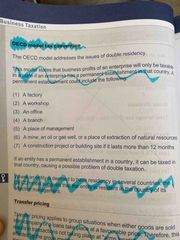
Back (Definition) |
|
|
Depn on land ? |
Land has no depn as it is deemed to have an limitless useful life |

